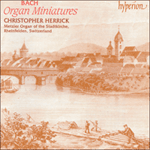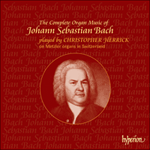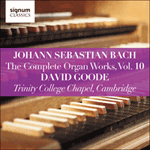During his time as Kapellmeister at the Court of Cöthen Bach produced hardly any organ music at all, and what he did produce is almost entirely arrangements of his own or other people’s music. Actually, to call the fugue of the Prelude and ‘Fiddle’ Fugue, BWV539, an ‘arrangement’ is something of a misnomer. The Fugue is in fact a thorough-going recomposition of the Fugue from the Sonata No 1 in G minor, for unaccompanied violin, BWV1001. The fugue subject is the soul of brevity and so Bach adds a tiny bit more presence to the exposition in the organ version by introducing one further entry, that in the pedals, thus making the current version two bars longer than the original. Whereas the solo violin can only hint at the continuity of simultaneous contrapuntal lines the hands and feet of the organist can make them real as well as spelling out the harmonic implications of a passage of arpeggios. As always when he reworked a piece, Bach could not resist making tiny adjustments, both harmonically and melodically, thus enriching the original. To introduce this delectable fugue Bach, rather than transcribing the rather flamboyant and declamatory Prelude of the Sonata, provides a more sober piece for manuals only, full of highly expressive dissonances.
from notes by Stephen Westrop © 1997
Während seiner Zeit als Kapellmeister am Köthener Hof komponierte Bach so gut wie keine Orgelmusik. Sein Schaffen beschränkte sich in jenen Tagen fast ausschließlich auf Arrangements seiner eigenen oder anderer Komponisten Musik. Die Fuge des Paares Präludium und Fuge, BWV539, jedoch als ein ‘Arrangement’ zu bezeichnen, wäre unzutreffend. Die Fuge ist nämlich in Wahrheit eine gründliche Neukomposition der Fuge aus der Sonate Nr. 1 in g-Moll für unbegleitete Violine, BWV1001. Das Fugenthema ist der Inbegriff von Knappheit, und aus diesem Grund verleiht Bach der Durchführung seiner Orgelversion durch einen zusätzlichen Themeneinsatz in den Pedalstimmen ein wenig mehr Substanz. Folglich ist diese Version auch zwei Takte länger als das Original. Während die Solovioline die Kontinuität gleichzeitiger kontrapunktischer Linien nur erahnen lassen kann, vermögen die Hände und Füße des Organisten diese Linien zum Leben zu erwecken und zudem die harmonischen Implikationen einer Arpeggiopassage zu verdeutlichen. Bach konnte der Versuchung nie widerstehen, winzige harmonische und melodische Änderungen bei der Überarbeitung eines Stückes zwecks der Bereicherung und Verbesserung des Originals vorzunehmen. Statt einer Transkription des recht pompösen und pathetischen Sonatenpräludiums sieht Bach als Einleitung dieser herrlichen Fuge ein eher schlichtes, ausschließlich für die Manualstimmen bestimmtes Stück mit einer Fülle überaus expressiver Dissonanzen vor.
aus dem Begleittext von Stephen Westrop © 1997
Deutsch: Manuela Hübner

 Bach: Organ Miniatures
Bach: Organ Miniatures Bach: The Complete Organ Works
Bach: The Complete Organ Works Bach: The Complete Organ Works, Vol. 10
Bach: The Complete Organ Works, Vol. 10
